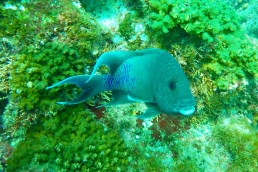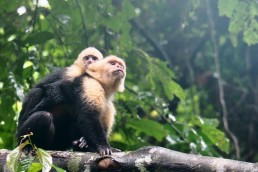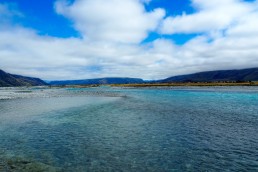On my second day in the area I had scheduled a tour into the park. Originally I wanted to hike through the entire park and stay at the Sirena Ranger Station but unfortunately they had no space left. For that reason I was left with with a day tour. In with a boat and then a guided hike for about 5-6h and back with the boat.

Based on whitehawkfoundation.org the forests of the Osa Peninsula (where the park is located on) are home to an unbelievable array of wild life: 4,000 to 5,000 species of vascular plants, including more than 700 of which are classified as trees, many of them endangered. Biologists estimate that 2/3 of the flora of the Osa exists nowhere else on earth. Based on this 2,5% of the entire worlds flora and fauna can be found here!
What can I say. After a wet landing on the beach we went into the jungle with a small group of six and our guide. He didn’t seem to be the happiest fellow but was a good spotter though. It’s an amazing park! You feel like being in a zoo but in fact it is just a “normal” forest. You can only imagine how much wildlife must be in the park based on the fact of how much we saw during this little time and on the “well-beaten” tracks.






One of the highlights was definitely to spot a tapir. They are critically endangered due to the decreasing amount of rainforest. We were lucky to find some traces of him feeding on roots and finally spotted him taking a nap in a bush. They are big!!

These are the guys waking you up in the morning. They are loud! During our visit they cut the gras landing strip next to the ranger station and the howler monkeys were complaining like crazy. The interpreted the grass cutters as intruders into their territory.

We stopped for a short break at the ranger station. And how nice is that – someone had just parked a plane for me to go for a round. I would have loved to give it a go…


Next absolute highlight which even got our guide exited was a sloth which came down the tree to do his business. That only happens every one or two weeks du to their slow metabolism. They come down their tree and burry their excrements so predators as the jaguar don’t know that they are in the area.



Not to forget about the little helpers. They harvest leave to grow fungus in their den.

The rainforest is just very diverse and offers a lot.




If you ever go to Costa Rica – it’s a must! In the evening back in the hostel one of the locals stopped by. He is one of the drivers behind a local initiative to support the turtle development in the bay. Most of the locals used to be poachers – taking the turtles and the eggs. But now at least one family member of the entire town is involved in protecting them. They patrol the beach every 4h in the six month season, dig out all eggs and hatch them safely in a conservation centre. Moreover they host volunteers, offer tours and with this have a different income source than selling turtle meat and eggs. So we where happy to contribute with 35$ and release about a 100 freshly hatched turtles into the sea at night.



Great finish of this amazing day. Next day – diving again…
Related Posts
1. December 2016
Parque National Manuel Antonio
1. September 2016
Golden Ears. A power hike with fantastic views.
10. February 2016





